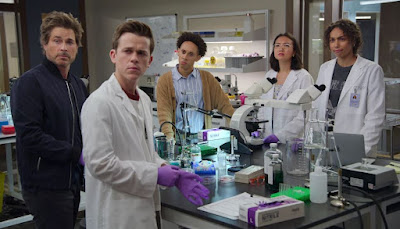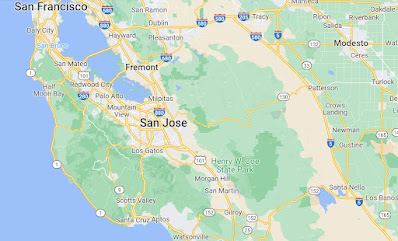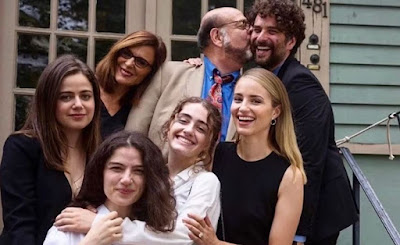At age 17, Andre Agassi won his first pro tournament, in Brazil, where, as soon as the final ended, he held his $90,000 check on one hand and kissed Brazilian girls in thongs in the other.
Agassi said he was never what the press wrote about him because when he explained himself to them, he never understood himself in the first place. One example: they wrote that he was punk rock, but he loved listening to “cheesy pop like Barry Manilow and Richard Marx.” Also, people thought he wore his hair in a long Mohawk because he wanted to stand out but it was really because he was losing it quickly and wanted as much of it as possible while he had the chance. Eventually, a friend in business school at Georgetown, during a meal at The Tombs (where, incidentally, I was recruited by professors before becoming a Hoya myself), convinced Agassi that all he had to do was start winning and the press would back off and maybe even start praising him.
Even though he had met Jimmy Conners several times growing up, when Agassi tried to talk to the legend before their first pro match, in the 1988 U.S. Open, Conners was “an asshole, rude, condescending, egomaniac prick” who said he didn’t remember him. Agassi destroyed Conners but lost in the next round once again to Ivan Lendl.
Cool tennis tip: If you identify someone’s weakness, for example a backhand, it might not always be best to hit to that backhand with pace. If you hit there without pace, the player will have to generate their own and it could increase their vulnerability.
Other than a match when Agassi was 10 and Pete Sampras from California was 9, the two played in Rome for the first time as pros and Andre won 6-2, 6-1, thinking Pete was so bad he’d never see him on tour again.
At the 1989 French Open, Jim Courier beat Agassi in the third round and rubbed it in by glaring at Andre in the locker room afterwards and going for a post-match run to show that Agassi didn’t provide enough of a cardio workout for him. Agassi was also disgusted that Michael Chang won the tournament and hence a Slam before him, as Chang thanked god “for making the ball go over the net.”
 |
| Agassi with Gil Reyes |
Agassi started training with a coach at UNLV, Gil Reyes, a real character who taught him that he had been training his body all wrong and it was a miracle he hadn’t already suffered a career-ending injury.
Cool tennis tip: For example, Reyes told Andre to stop running five miles a day because when do you ever do that in a tennis match? He said Andre didn’t need to be training his long-distance muscles but rather his start-and-stop muscles. Which makes a ton of sense especially to me, since I hate running for running’s sake.
Gil eventually quit work at the university and began working full time with Andre, In a scene straight out of Fear and Loathing in Las Vegas, the two took Andre's Corvette from Vegas to Scottsdale for a celebrity tournament and they get two speeding tickets. The policeman took them 45 minutes to court in the town of Kingman, where the judge proceeded to fawn over Andre and get many autographs from him. Turns out the judge was a huge tennis fan and, instead of sentencing Andre, told him to go give ‘em hell in the tourney, but to have Gil drive the rest of the way.
Gil didn’t try to change Andre because if he could have done that, he said he would have changed himself. But he did believe he could give Andre structure and a blueprint for achieving his goals. He said they were going to be fighters together and that it was “on.”
The night before Agassi’s first final of a Grand Slam, the 1990 French Open, having already disposed of Jim Courier and Michael Chang, his hairpiece fell apart and his brother has to run all over Paris to find bobby pins to keep it in place during the match. Agassi lost to Ecuador’s Andrés Gómez, but at least he didn’t lose his hairpiece.
Agassi skipped Wimbledon but added 10 pounds of muscle working with Gil over the summer and showed up lean and mean for the U.S. Open. He licked his lips when he got to the final, knowing he was about to play that guy who looked so bad just a year ago. Pete Sampras, who had just beaten John McEnroe in the previous round, disposed of Andre 6-4, 6-3, 6-2.
He lost his third Slam title in a row to Jim Courier at the 1991 French Open. He said he had a strong will to lose - lose, not win - at 4-4 in the fifth set.
One thing that’s amazing to me is how many Slams Agassi just skipped. Throughout his early years, he completely avoided the Australian Open. You don’t find that with today’s pros much, unless they are injured. I wonder how many more Slams Agassi could have accrued.
After a night in Argentina at the Davis Cup, Andre went out and drank too much with McEnroe and his wife Tatum O’Neal. The next day he played hungover but plated well, wearing Oakley sunglasses to cover up his red eyes. Soon, the founder of Oakley sent him a red Dodge Viper.
At age 22, Agassi, after beating Boris Becker and McEnroe along the path, finally got his first Grand Slam title, at the 1992 Wimbledon, in five sets over Goran Ivanisevic, who would later go on to become Novak Djokovic’s coach. Perhaps most of all, he couldn’t wait to attend that night’s famed Wimbledon Ball, where the men’s winner got to dance with the women’s champ. Andre had a crush on Steffi Graf since he’s first seen her. Andre was then informed by the stuffy attendees that they don’t have that dance tradition anymore, but he did get to meet Steffi briefly and told her he would love to get together and talk with her sometime.
Then, Agassi fired up a friendship with Barbra Streisand and learned that she too had a powerful talent - singing - that she hated to use, like him with tennis. He actually dated her, despite the 28-year difference and she told reporters he was a “Zen master.” I find his love of soft-rock legends like Streisand, Manilow, Marx, Celine Dion, Kenny G, and Michael Bolton hilarious and one of the most endearing things about Agassi - very much in contrast to his bad boy (and unwanted by him) “Image is Everything” persona.
As he recovered from a fairly serious wrist surgery, Kenny G’s wife Lyndie set him up with Brooke Shields. She was in the African bush making a movie and the only way they could begin contacting each other was via fax machine. The faxes soon became intimate and Andre soon stopped calling Barbra.
Agassi met with the quirky player/coach Brad Gilbert, author of Winning Ugly, and Brad said Andre appeared to have lost the fire he had at age 16, when he used to take the ball early and aggressively. He said Andre’s problem was his perfectionism, which messed with his head when he inevitably fell short. He said, with the talent Andre had, he didn’t need to go for the winners every time, but rather to be solid and remember the other guy has weaknesses to be attacked.
Cool tennis tip: Gilbert said to think about how many sets it will take to win a tournament (21 in the Slams) and count backwards from there - simplify and focus on that number.
After Brad talked at him for a while and then convinced him which pasta to order, it was clear that Brad Gilbert needed to join Andre’s team and become his coach. Andre then prceeded to go on a terrible losing streak, but Gilbert kept telling him good things were about the start happening.
Coach was right. Andre beat Michael Stich to win the 1994 U.S Open. He finally realized that he had the team around him that he wanted, once Brooke and Brad rounded it out. (And weirdly enough, Brooke’s grandfather Frank Shields was the last unseeded player, in 1966, until Andre in 1994, to win the Open.)

































